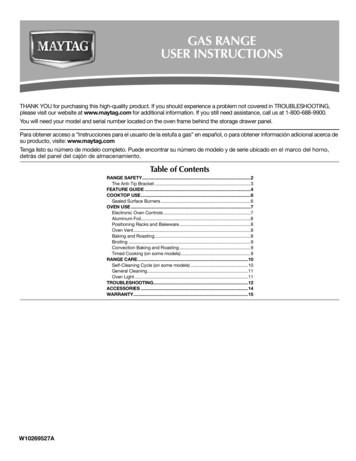Onion Root Tip Lab Report - Portfolio Of Hannah Scott
Onion Root Tip Lab ReportHannah ScottBiologyMs. CarpenterFebruary 25, 2013
Problem, Hypothesis and PredictionIn this lab experiment, Hannah was to analyze an onion root tip under amicroscope to observe the mitotic stages that occur in the cells of onion root tips.The problem was, at what rate does mitosis occur in different parts of the onionroot? The hypothesis that was being considered is this: The stage of interphase willmore likely be the stage spotted in most of the cells because it is the longest stage,therefore easier to observe. Hannah predicts that she will see more cells goingthrough interphase than any other phase of the cell cycle.Materials:Onion Root TipScallopOne small cupToluidine Bluecontaining HCIPaper towelOne small cupWatercontaining CarnoyCover SlipForcepsMicroscopePrepared SlideDropper
Procedure:First, a pre-ready slide was provided. On this slide was an onion root tip.Area X was located on low power. Once that was achieved, Hannah switched tohigh power. She created a data table. After counting and observing the cells. Then,she recorded how many cells were found in each phase of mitosis and interphasefor area X.Area Y was then located on low power, using the same slide. Then, Hannahswitched to high power. Hannah began to count the cells that were undergoingmitosis and interphase. She tallied the amounts of each as she counted. The cellsthat were in mitosis and interphase were recorded in a data chart.Hannah had two small cups and filled and labeled one with HCI and onewith Carnoy. She used Forceps to transfer an onion root tip into the HCI. Afterfour minutes, it was transferred to the Carnoy. After four minutes, it was thenplaced on a slide. Using a scallop, every part of the onion root was cut off andtrashed but the very tip. The root tip was covered for two minutes with Toluidineblue and blotted with a paper towel. Then, a drop of water covered it and a coverslip was pressed on. The slide was then placed on the microscope. Area Z was thenlocated on low power. The number of cells undergoing mitosis and interphase wererecorded in a data chart. The mess was then cleaned up.
Data:Phase:Number of cells in Number of CellsNumber of Cells inArea Xin Area YArea e6111Telophase6327
Calculations:Percentages83/140 59%41/140 29%4/140 3%Analysis and Conclusion:This lab was an experiment designed to analyze how many cells could beobserved in each part of mitosis for different areas of an onion root. First, with aprepared slide, area X and Y were located and each counted and recorded of whatstages were observed. Then, another onion root tip was prepared and area Z waslocated. With the data of all three areas, the mitotic stages were able to be easilyanalyzed.The problem in this experiment was at what rate does mitosis occur indifferent parts of the onion root? The hypothesis that was considered was that thestage of interphase will more likely be the stage spotted in most of the cellsbecause it is the longest stage, therefore easier to observe. After completing theexperiment, the hypothesis proved to be true in two areas of the cell and not true inone area of the cell. In area X, 59% of the cells were spotted in Interphase. There
was 29% in Prophase, 3% in Metaphase, 5% in Anaphase and 4% in Telophase. Inarea Y, 66% was spotted in interphase. There was 30% in Prophase, 1% inMetaphase, 1% in Anaphase and 2% in Telophase. In area Z, the higher percentageof 43% was found in prophase rather than interphase. There was 13% inInterphase, 3% in Metaphase, 12% in Anaphase, and 29% in Telophase.In this experiment, a component that went wrong was the percentages of thedifferent phases in area Z. A majority of the cells were not found in Interphase,unlike the other areas. This impacted the project by changing the outcome anddata. It did not fit with the hypothesis like the other areas of the onion root tip. Thisproblem could have occurred because of a miscount or because that specific area ofthe root tip had more cells engaging in prophase than interphase. This error thatoccurred is most likely due to a fault of human.Question and Answer:1. Which area of the onion root tip (X or Y or Z) had the greatest percentageof cells undergoing mitosis? The lowest? Use specific totals from yourdata table to support your answer. Part Z has the greatest percentage ofcells undergoing mitosis with, 87%. Area X has 41% of cells undergoingmitosis and Area Y has the lowest percentage with 34% of cellsundergoing mitosis.
2. If mitosis is associated with rapid growth, where do you believe is thelocation with the most rapid root growth, area X, Y, or Z? The most rapidroot growth occurred in part Y because area Y had the lowest, 34%, ofmitosis being observed. This means it was happening to quick to be seen.And this means that area Y has the most rapid root growth.3. Where might you look for cells in your body that are undergoing mitosis?You would look in skin and hair cells because those kinds of places inyour body are always growing and healing.4. Assume that you were not able to observe cells in every phase of mitosis.Explain why this might be considering the length of each phase?Interphase is the longest phase, so that made it easier to observe.Prophase is the next to be longest, so it was also observed easier.Telophase is also less rapid, making it easier to spot as well. ButMetaphase and Anaphase are very rapid making them hard to observe. Inall three areas Metaphase and Anaphase had some of the lowestpercentages of cells; Area X had 3% for Metaphase and 5% forAnaphase, area Y had 1% for both Metaphase and Anaphase, and area Zhad 3% for Metaphase and 12% for Anaphase.5. What factors might cause misleading results? How could you avoid theseproblems? Factors that could cause misleading results and errors are that
this experiment was conducted by nonprofessionals and so cells mayhave been miscounted or some cells may have been misinterpreted bywhat phase they were actually in. Also, it could have been poorly focusedlens causing a blur. All of these factors could be fixed by being cautiousof what could have happened and been worked out ahead of time. Suchas, double checking your counts and claims on the phases andproficiently focusing the lenses.6. What are the possible discrepancies that could have or did occur in thedata when comparing the numbers of cells in each phase between the Xand Y and Z samples? A discrepancy that occurred in the data was thatboth areas X and Y had the most cells being observed in Interphase, butarea Z did not match with those results. It had the most percentages forcells being observed in Prophase instead.7. What steps could you take to ensure that the next time you complete a labin class the accuracy of the data will be precise? You could take moreprecise precautions, such as recounting your cells again or doublechecking to verify which stage that the cells were actually in. A bigproblem that could be fixed is taking your time with it rather thanhurrying to try and count all the cells. Taking your time with countingwould have succumbed for most of the discrepancies.
mitosis and interphase. She tallied the amounts of each as she counted. The cells that were in mitosis and interphase were recorded in a data chart. Hannah had two small cups and filled and labeled one with HCI and one with Carnoy. She used Forceps to transfer an onion root tip into the HCI. After four minutes, it was transferred to the Carnoy.
LAB EXPERIMENT 4: Mitosis in Onion Root Tip Cells Objective After completing this exercise, you should be able to: 1. Better understand the process and stages of mitosis. 2. Prepare your own specimens of onion root in which you can visualize all of the stages of mitosis. 3.
Onion Cell Mitosis Background: In a growing plant root, the cells at the tip of the root are constantly dividing to allow the root to grow. Because each cell divides independently of the others, a root tip contains cells at different stages of the cell cycle. This makes a root tip an excellent tissue to study the stages of cell division. Materials:
Tip 14 - Group Photos Made Easy Tip 15 - Rare Rainy Day Photos Tip 16 - Controlling Color in Indoor Photos Tip 17 - Sharp Action Photos Tip 18 - Landmarking Landscape Photos Tip 19 - Better Digital Photo Color Tip 20 - Portrait Photos that Impress Tip 21 - Flash and Action (Flash Freeze) Tip 22 - Using Depth of Field
Biology Lab Notebook Table of Contents: 1. General Lab Template 2. Lab Report Grading Rubric 3. Sample Lab Report 4. Graphing Lab 5. Personal Experiment 6. Enzymes Lab 7. The Importance of Water 8. Cell Membranes - How Do Small Materials Enter Cells? 9. Osmosis - Elodea Lab 10. Respiration - Yeast Lab 11. Cell Division - Egg Lab 12.
The range will not tip during normal use. However, the range can tip if you apply too much force or weight to the open door wit hout the anti-tip bracket fastened down properly. Tip Over Hazard A child or adult can tip the range and be killed. Connect anti-tip bracket to rear range foot. Reconnect the anti-tip bracket, if the range is moved.
7 [ROOT likes] [.] A [ OBJ(likes,books) Right Arc(OBJ) 8 [ROOT likes .] ; Shift 9 [ROOT likes] ; A [ P(likes,.) Right Arc(P) 10 [ROOT] ; A [ ROOT(ROOT,likes) Right Arc(ROOT) Figure 2: An example of arc-standard transition dependency parsing. s3 s2 s1 b1 b2 b3 s2.lc1 s2.lc2 s2.rc2 s2.rc1 s2.rc2.lc1 2 rc2
7.5 Graphing Square Root and Cube Root Functions 431 Graph square root and cube root functions. Use square root and cube root functions to find real-life quantities, such as the power of a race car in Ex. 48.
This asset management policy provides the framework for the care and control of IT assets through their life cycle. The 5 life cycle phases cover acquisition, deployment, operation and maintenance through to decommissioning (retirement) and disposal of assets. The primary purposes of asset management are to: Support delivery of IT services in line with customers’ business plans .























